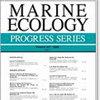Discriminating populations of Atlantic herring mixing in the Norwegian Sea feeding ground using single nucleotide polymorphisms (SNPs)
IF 2.2
3区 环境科学与生态学
Q2 ECOLOGY
引用次数: 0
Abstract
ABSTRACT: Atlantic herring Clupea harengus feeding in the Norwegian Sea are assumed to consist of Norwegian spring spawners (NSSH), Icelandic summer spawners (ISSH) and North Sea autumn spawners (NSAH). Putative Norwegian autumn spawners (NASH), Faroese autumn (FASH) and spring (FSSH) spawners also feed in the area. However, until there is a method to discriminate between populations in mixed samples, fishery and survey data from the Norwegian Sea will be solely attributed to the predominating NSSH, ultimately causing biased stock assessments. Hence, we evaluated if a panel of 120 single nucleotide polymorphisms (SNPs) associated with spawning characteristics and salinity preferences would be an effective discrimination tool. The overall observed levels of genetic differentiation were high (FST = 0.57, p <0.001, 95% CI: 0.51-0.62). Spawners from stocks under current management (NSSH, NSAH and ISSH) were well separated, but the putative populations were not. Discriminant analysis of principal component as well as Structure runs confirmed the differentiation observed with FST. When the SNP panels were tested on commercial fishery samples of NSSH east of Iceland, up to 16% were assigned to ISSH. This implies that catch data are seriously biased and demonstrates the potential of SNP panels as a tool to solve the problem. However, work is needed to develop improved SNP panels that effectively separate the putative populations from the managed stocks. We recommend that such a tool should be established in regular sampling of fishery and surveys in the Norwegian Sea and accounted for in future stock assessments, advice and management.利用单核苷酸多态性(SNPs)区分挪威海觅食地大西洋鲱鱼混合种群
摘要:在挪威海觅食的大西洋鲱鱼(Clupea harengus)假定由挪威春季产卵者(NSSH)、冰岛夏季产卵者(ISSH)和北海秋季产卵者(NSAH)组成。假定的挪威秋季产卵者(NASH)、法罗群岛秋季产卵者(FASH)和春季产卵者(FSSH)也在该地区觅食。然而,在找到区分混合样本中不同种群的方法之前,挪威海的渔业和调查数据将完全归因于占主导地位的NSSH,最终导致种群评估出现偏差。因此,我们评估了与产卵特征和盐度偏好相关的 120 个单核苷酸多态性(SNPs)是否是一种有效的区分工具。观察到的总体遗传分化水平较高(FST = 0.57,p <0.001,95% CI:0.51-0.62)。目前管理下的种群(NSSH、NSAH 和 ISSH)的产卵者分离得很好,但推定种群则不然。主成分和结构运行的判别分析证实了通过 FST 观察到的区分。在对冰岛以东的 NSSH 商业渔业样本进行 SNP 面板测试时,高达 16% 的样本被归入 ISSH。这意味着渔获量数据存在严重偏差,并证明了 SNP 面板作为解决这一问题的工具的潜力。不过,还需要努力开发改进的 SNP 面板,以有效区分假定种群与管理种群。我们建议在挪威海的定期渔业采样和调查中建立这样的工具,并在未来的种群评估、建议和管理中加以考虑。
本文章由计算机程序翻译,如有差异,请以英文原文为准。
求助全文
约1分钟内获得全文
求助全文
来源期刊

Marine Ecology Progress Series
环境科学-海洋学
CiteScore
5.30
自引率
8.00%
发文量
238
审稿时长
3 months
期刊介绍:
The leading journal in its field, MEPS covers all aspects of marine ecology, fundamental and applied. Topics covered include microbiology, botany, zoology, ecosystem research, biological oceanography, ecological aspects of fisheries and aquaculture, pollution, environmental protection, conservation, and resource management.
 求助内容:
求助内容: 应助结果提醒方式:
应助结果提醒方式:


